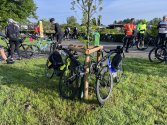Karl42
Well-Known Member
This year I've started to do a full series of Brevets here in Germany on my V20, doing the usual sequence of 200km, 300km, 400km, and 600km (for those thinking in miles, these distances are 125mi, 186mi, 250mi, and 372mi).
On my own, I often do 200-300km (up to 186mi) in one day, which can still comfortably be done mostly in daylight.
My experience with rides that cover more distance than that in a single session is limited to a 24 hour cycling marathon that is held anually in June here in Germany. There I've ridden up to 640km / 400mi within 24 hours on my V20. This marathon uses a track that is almost exactly 10 miles long (16.7 km) and takes around half an hour for one lap. It is on a public road, but has no traffic lights, and ideal conditions for going really fast. Also, being able to do a rest stop after every lap means I can go without any luggage.
Doing a long fully self-supported Brevet is an entirely different beast, as I need to bring clothing for every kind of weather, and enough food for 20 hours on the bike, and tools and spare parts, as well as walkable shoes, in case something goes wrong. And enough batteries to power the lights through the night.
Doing two 200km and one 300km Brevet in the previous weeks has been fairly straightforward and easy. The Brevets here really are all-weather events, and we had lots of rain, hail, and even some snow. It's all a matter of bringing the right clothing for this and being mentally prepared for it.
The 400km Brevet I did last weekend started on Saturday evening at 8pm, so we would cycle into and through the night. The weather forecast was cautiously optimistic, but did warn of a storm front that might cross our path and bring torrential rain, hail, and thunderstorms. Maybe because of this only half the registered attendees had showed up for the ride. But it worked out quite well, and apart from some light rain and some fog the weather was quite nice for most of the trip.
The ride featured a distance of 402km (about 250mi), 3800 meters (12500 feet) of climbing, and scenic routes through various nature parks.

We set off at 8pm. We were accompanied by a light drizzle, which gave us many beautiful rainbows in the evening hours:

Then it got drier again and continued south through the Bergisches Land, where there were already many meters of climbing to collect. Shortly after midnight, I crossed the Sieg bridge near Hennef and enjoyed this surreal atmosphere in the night light:

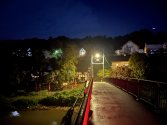
Then it became very foggy. On the one hand, it was a rare and exciting experience to ride through winding forest roads in complete darkness, but the fog constantly collected small droplets on my cycling glasses, and the already poor visibility was reduced even further. The photo doesn't fully convey how bad the visibility really was:
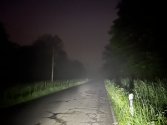
At the petrol station in Neuwied at kilometer 163 I met many of my fellow riders again, and then I crossed the Rhine bridge to the left side of the Rhine into the Eifel.
At around 4am, I started to feel quite tired. Every time I put my head back in the neck support, my eyes closed for a moment. Why is a recumbent bike so comfortable that you want to fall asleep on it?
I started looking for a place to sleep and found a flat spot with a wall to lean against. I tried sleeping on my bike for the first time. And indeed, lying on the bike with my shoes clipped in and my head leaning sideways against the wall, I was able to relax completely and remain stable leaning against the wall. So I was able to doze off and relax for half an hour until shortly before 5pm.
At the start, we were advised to time it so that we could see the early morning hours and the sunrise in the Eifel National Park. By now, dawn had broken and I was rewarded with the most beautiful part of this tour. Accompanied by the twittering of birds and other sounds of nature, I enjoyed the many views of the morning mist rising from the forest:

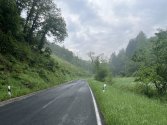
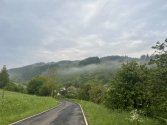
At the end of the Eifel we rode past the Nürburgring (a major race track for car races), where I arrived shortly before 8:00 am. There were a lot of extremely tuned-looking cars driving around. Even in the early hours of the morning, you could already hear the racing drivers on the ring. I'd better get away from this paradise for car nerds quickly before I end up in an unpleasant situation on my bike. The Nürburgring was also the highest point of the tour, and after that it was almost all downhill. The hardest parts of the tour (in terms of night riding and climbing) were now done, the rest was just 180km / 111mi of coasting to get home.
After the Eifel we came to the Ahr valley, which I remembered from the 200km brevet a few weeks ago. This time the water level in the river was much higher, which brought up bad memories from the flood catastrophe here a few years ago.
After the Ahr valley, we were finally back in the flatlands, and there was no more interesting scenery. It was now around midday, but I estimated that I still had five hours ahead of me for the last 100km. My hamstring was starting to make itself felt, so I could only continue at a very relaxed pace. But it was now flat and, apart from a few showers, mostly sunny.
It was only in the last half hour that it started to rain again (as it had done on my last brevet), but this time it was relatively warm, so the rain actually felt a bit pleasant and refreshing after 20 hours on the bike.
I arrived at the finish point at around 5pm. Due to the many puddles and rainy stages, my bike was completely dirty again. I now understand why the randonneurs all have mudguards. Maybe I can somehow fit some on my V20 too.

All in all, it was a very nice route with lots of magical moments. I particularly enjoyed the morning hours in the Eifel National Park, which made the night ride before totally worth it. Now I'm looking forward to the 600km event in two weeks.
On my own, I often do 200-300km (up to 186mi) in one day, which can still comfortably be done mostly in daylight.
My experience with rides that cover more distance than that in a single session is limited to a 24 hour cycling marathon that is held anually in June here in Germany. There I've ridden up to 640km / 400mi within 24 hours on my V20. This marathon uses a track that is almost exactly 10 miles long (16.7 km) and takes around half an hour for one lap. It is on a public road, but has no traffic lights, and ideal conditions for going really fast. Also, being able to do a rest stop after every lap means I can go without any luggage.
Doing a long fully self-supported Brevet is an entirely different beast, as I need to bring clothing for every kind of weather, and enough food for 20 hours on the bike, and tools and spare parts, as well as walkable shoes, in case something goes wrong. And enough batteries to power the lights through the night.
Doing two 200km and one 300km Brevet in the previous weeks has been fairly straightforward and easy. The Brevets here really are all-weather events, and we had lots of rain, hail, and even some snow. It's all a matter of bringing the right clothing for this and being mentally prepared for it.
The 400km Brevet I did last weekend started on Saturday evening at 8pm, so we would cycle into and through the night. The weather forecast was cautiously optimistic, but did warn of a storm front that might cross our path and bring torrential rain, hail, and thunderstorms. Maybe because of this only half the registered attendees had showed up for the ride. But it worked out quite well, and apart from some light rain and some fog the weather was quite nice for most of the trip.
The ride featured a distance of 402km (about 250mi), 3800 meters (12500 feet) of climbing, and scenic routes through various nature parks.

We set off at 8pm. We were accompanied by a light drizzle, which gave us many beautiful rainbows in the evening hours:

Then it got drier again and continued south through the Bergisches Land, where there were already many meters of climbing to collect. Shortly after midnight, I crossed the Sieg bridge near Hennef and enjoyed this surreal atmosphere in the night light:


Then it became very foggy. On the one hand, it was a rare and exciting experience to ride through winding forest roads in complete darkness, but the fog constantly collected small droplets on my cycling glasses, and the already poor visibility was reduced even further. The photo doesn't fully convey how bad the visibility really was:

At the petrol station in Neuwied at kilometer 163 I met many of my fellow riders again, and then I crossed the Rhine bridge to the left side of the Rhine into the Eifel.
At around 4am, I started to feel quite tired. Every time I put my head back in the neck support, my eyes closed for a moment. Why is a recumbent bike so comfortable that you want to fall asleep on it?
I started looking for a place to sleep and found a flat spot with a wall to lean against. I tried sleeping on my bike for the first time. And indeed, lying on the bike with my shoes clipped in and my head leaning sideways against the wall, I was able to relax completely and remain stable leaning against the wall. So I was able to doze off and relax for half an hour until shortly before 5pm.
At the start, we were advised to time it so that we could see the early morning hours and the sunrise in the Eifel National Park. By now, dawn had broken and I was rewarded with the most beautiful part of this tour. Accompanied by the twittering of birds and other sounds of nature, I enjoyed the many views of the morning mist rising from the forest:



At the end of the Eifel we rode past the Nürburgring (a major race track for car races), where I arrived shortly before 8:00 am. There were a lot of extremely tuned-looking cars driving around. Even in the early hours of the morning, you could already hear the racing drivers on the ring. I'd better get away from this paradise for car nerds quickly before I end up in an unpleasant situation on my bike. The Nürburgring was also the highest point of the tour, and after that it was almost all downhill. The hardest parts of the tour (in terms of night riding and climbing) were now done, the rest was just 180km / 111mi of coasting to get home.
After the Eifel we came to the Ahr valley, which I remembered from the 200km brevet a few weeks ago. This time the water level in the river was much higher, which brought up bad memories from the flood catastrophe here a few years ago.
After the Ahr valley, we were finally back in the flatlands, and there was no more interesting scenery. It was now around midday, but I estimated that I still had five hours ahead of me for the last 100km. My hamstring was starting to make itself felt, so I could only continue at a very relaxed pace. But it was now flat and, apart from a few showers, mostly sunny.
It was only in the last half hour that it started to rain again (as it had done on my last brevet), but this time it was relatively warm, so the rain actually felt a bit pleasant and refreshing after 20 hours on the bike.
I arrived at the finish point at around 5pm. Due to the many puddles and rainy stages, my bike was completely dirty again. I now understand why the randonneurs all have mudguards. Maybe I can somehow fit some on my V20 too.

All in all, it was a very nice route with lots of magical moments. I particularly enjoyed the morning hours in the Eifel National Park, which made the night ride before totally worth it. Now I'm looking forward to the 600km event in two weeks.
Last edited:

